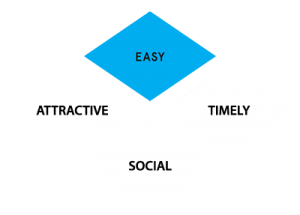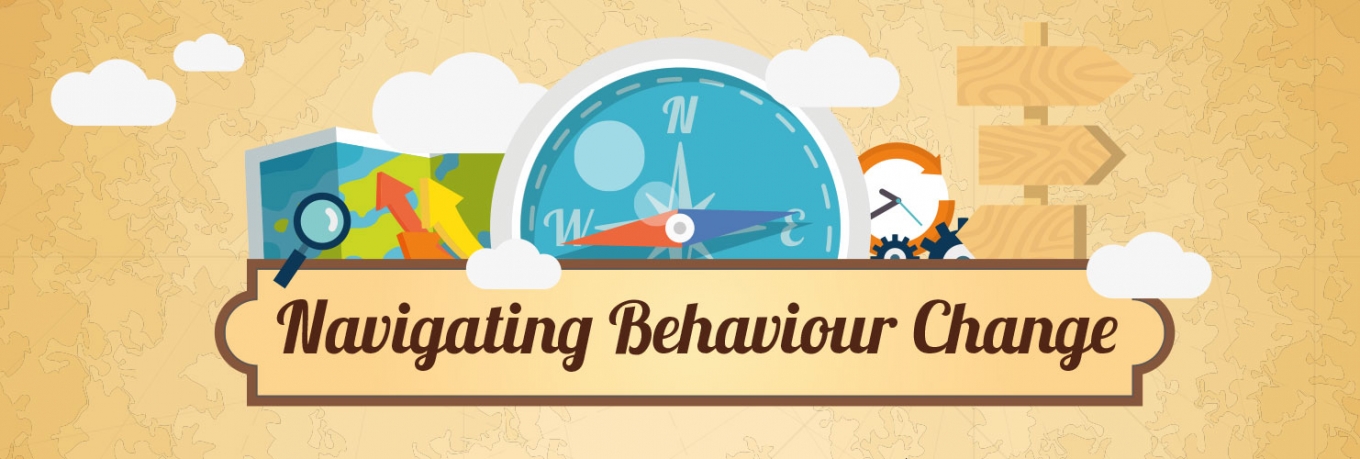Behaviour change is at the heart of internal communication.
We shape employee behaviours in order to navigate through change, deliver the promises our companies make and drive business results. How do we equip ourselves with the necessary tools and skills to achieve this?
If you want to encourage a behaviour, make it Easy, Attractive, Social and Timely (EAST).
 These four simple principles form the EAST structure. This framework was developed by the Behavioural Insights Team (BIT) the world’s first government institution dedicated to the application of behavioural sciences. Sounds like a mouthful – in essence it’s all about understanding and simplifying complex approaches to look at how behaviours help create better policy and a better society.
These four simple principles form the EAST structure. This framework was developed by the Behavioural Insights Team (BIT) the world’s first government institution dedicated to the application of behavioural sciences. Sounds like a mouthful – in essence it’s all about understanding and simplifying complex approaches to look at how behaviours help create better policy and a better society.
When the BIT (also known as The Nudge Unit) was formed in 2010 one of its key objectives was to spread the understanding of behavioural approaches. Many trials, seminars, workshops and talks took place, leading to the creation of the simple, logical EAST structure.
According to the BIT, “Though we do not claim that EAST is a comprehensive summary of all there is to know about behavioural science, we do think that for busy policymakers, the EAST framework is an accessible, simple way to make more effective and efficient policy.”
This framework has helped to generate policy that’s smarter, simpler and highly cost-effective.
Adopting EAST internally
It’s interesting how these principles can be adapted for behaviour change within other environments, specifically in organisations where communication programmes are focused on encouraging or discouraging particular behaviours.
The EAST principles are a brilliant reminder of what should be considered when influencing employee behaviour change. They include:
MAKE IT EASY
- Harness the power of defaults. We have a strong tendency to go with the default or pre-set option, since it is easy to do so. Making an option the default makes it more likely to be adopted.
- Reduce the ‘hassle factor’ of taking up a service. The effort required to perform an action often puts people off. Reducing the effort required can increase uptake or response rates.
- Simplify messages. Making the message clear often results in a significant increase in response rates to communications. In particular, it’s useful to identify how a complex goal can be broken down into simpler, easier actions.
MAKE IT ATTRACTIVE
- Attract attention. We are more likely to do something that our attention is drawn towards. Ways of doing this include the use of images, colour or personalisation.
- Design rewards and sanctions for maximum effect. Financial incentives are often highly effective, but alternative incentive designs — such as lotteries — also work well and often cost less.
MAKE IT SOCIAL
- Show that most people perform the desired behaviour. Describing what most people do in a particular situation encourages others to do the same. Similarly, policy makers should be wary of inadvertently reinforcing a problematic behaviour by emphasising its high prevalence.
- Use the power of networks. We are embedded in a network of social relationships, and those we come into contact with shape our actions. Governments can foster networks to enable collective action, provide mutual support, and encourage behaviours to spread peer-to-peer.
- Encourage people to make a commitment to others. We often use commitment devices to voluntarily ‘lock ourselves’ into doing something in advance. The social nature of these commitments is often crucial.
MAKE IT TIMELY
- Prompt people when they are likely to be most receptive. The same offer made at different times can have drastically different levels of success. Behaviour is generally easier to change when habits are already disrupted, such as around major life events.
- Consider the immediate costs and benefits. We are more influenced by costs and benefits that take effect immediately than those delivered later. Policy makers should consider whether the immediate costs or benefits can be adjusted (even slightly), given that they are so influential.
- Help people plan their response to events. There is a substantial gap between intentions and actual behaviour. A proven solution is to prompt people to identify the barriers to action, and develop a specific plan to address them.
The EAST Model ‘checklist’
Every conversation in internal communication begins with ‘What do we want people to do and how do we want people to behave as a result?’ A reliable structure to help guide us through the elements of behaviour change is therefore a fundamental requirement.
By turning the points above into a kind of ‘checklist’, internal communicators can make the EAST Framework a valuable addition to their comms toolkits.
When you’re navigating behavioural change there’s a smart direction to explore – head EAST.
If you’d like support with an employee behavioural change programme then drop us a line. We’d love to help!
















